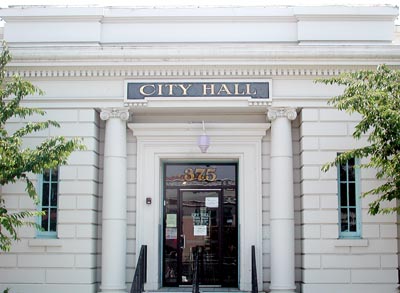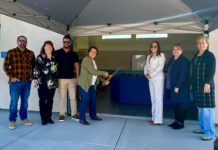Hollister council members are considering a regional community choice energy project.
The project is Monterey Bay Community Power, a future joint powers authority comprised of agencies in Monterey, Santa Cruz and San Benito counties. It allows participating communities to choose where their power comes from at rates equal to or better than PG&E.
“Everything sort of remains the same,” City Manager Bill Avera said to council members. “PG&E provides transmission of power, administration of the billing. They take care of most aspects, but the source of that energy is actually coming from a green source.”
The project’s website (http://montereybaycca.org) states that surplus revenue that normally goes to PG&E will stay in the community to help fund renewable energy projects, create jobs and stimulate the economy.
Avera said that of the 21 potential participating agencies in the Monterey Bay area, 19 of them have passed resolutions of intent to participate in the project. Hollister and Sand City are the two remaining communities who have yet to adopt a resolution. San Benito County supervisors passed their resolution late last year.
If Hollister decides to participate in the project, residents would automatically be opted in to the community choice energy model. Residents would be able to choose to opt out and could use PG&E as the default option.
Mayor Ignacio Velazquez said he was bothered that customers have to opt out and not the other way around.
“If this was a situation where customers can opt in, I wouldn’t have such an issue with it,” Velazquez said. “I have a problem forcing people to do something and then say ‘Oh, I want out now.’ There’s a lot of ways to provide power out there, I’m in this business myself. I don’t want to be in a situation where I’m telling somebody what they have to do. I want to be in a situation where I’m allowing somebody to decide what they want to do.”
Monterey Bay Community Power Program Manager Gine Johnson gave a presentation on the project, which included a summary video, at the recent meeting.
“The video we have produced as part of the outreach for the community actually summarizes what is a very highly technical analysis that we’ve conducted,” Johnson said. “Over 300 pages of analysis, performance as well as sample legal documents, etcetera, based on best practices from other (community choice energy models) in the state.”
Johnson showed a few slides after the video and talked about the successes of Sonoma Clean Power, another community choice energy model in California.
“They’ve actually been live for two and a half years,” Johnson said. “They have 89 percent of the total electricity customers. That’s almost 200,000 customers. Of course, PG&E continues to provide their gas service and electricity to the other 11 percent. Their annual budget is $165 million a year, I’m rounding up of course. You can see that their net assets, after they’ve paid off all their startup debt, is $35 million in this slide. But I’m here to tell you it’s $50 million as we stand here today, because they are booking surplus revenues of over $1 million dollars per month as we speak.”
Johnson said Sonoma Clean Power has a 36 percent renewable portfolio compared to the 27 percent that PG&E provides.
“Their rates now are on average 8 percent lower than PG&E with that increased renewable portfolio,” Johnson said. “They are 80 percent carbon-free. Their startup costs were paid off very shortly after startup. So a very exciting success, both an environmental success and economic success.”
Council members were cautious toward the potential of Monterey Bay Community Power. Councilman Karson Klauer at the recent meeting asked Johnson if she could guarantee long-term rate parity.
“The short answer is no,” Johnson said. “However the marketplace is incredibly favorable right now for renewables… To answer your question more fully, we will have a local governing board that will be able to control rates.”
Councilman Ray Friend said he had no problem with renewable energy, but didn’t like that Sonoma Clean Power was used as an example.
“I hate the fact that they’re using Sonoma County as their guidepost,” Friend said. “The State of California gave Sonoma County 18 geothermal units and said ‘Here, create your own little utility company.’ They don’t pay for that power that comes out of the geysers. They were given their own power supply. (Monterey Bay Community Power) does not have any power plants. Everything that this group supplies to the residents, they’re out on the stock market getting everyday.”
Friend said he had another problem with the talk of job creation.
“If PG&E is going to be providing the power, wielding the power, providing the administration and the bills, except for building new solar plants, what new jobs could possibly be coming out of this except for the people that are hired to do the buying and selling on the market?” Friend asked. “And those probably will be in some building in Monterey County somewhere… To think that this group can get together and in a few years have their own solar program, I think is a real pie-in-the-sky.”
Johnson said she sees 15 of the 19 agencies who’ve passed resolutions of intent to participate moving forward on the joint powers authority.
“According to state mandates, the State of California legislation now says that we have to get 50 percent of our power from renewable sources by 2030 and in fact (Monterey Bay Community Power) will be making that threshold before the end of 2019. So we’d be making that goal much quicker.”
Councilwoman Mickie Luna thanked Johnson for her presentation and said she wanted to hear more from the community.
“I want to hear more from the community, I do want to know how they feel about this,” Luna said. “Tonight, nine people spoke and we have a large population in the City of Hollister. So I know many are watching tonight, but I just feel like I’d like to hear from other residents in regards to this.”
By the end of the study session earlier this month, Avera said he’d agendize the resolution of intent for the Feb. 6 council meeting. The resolution would require a first and second reading before adoption.








